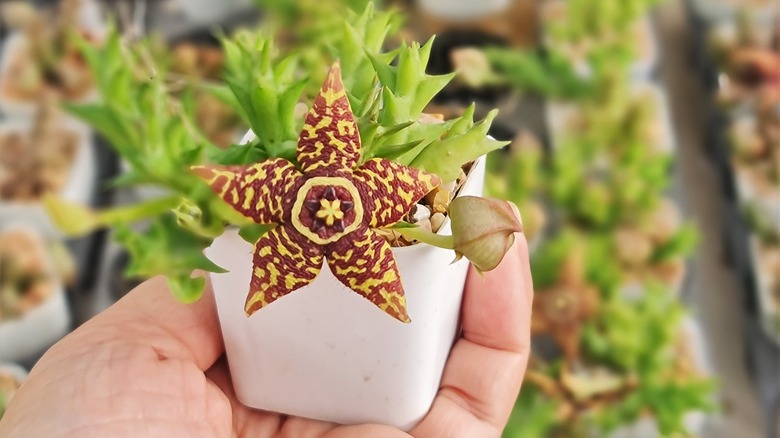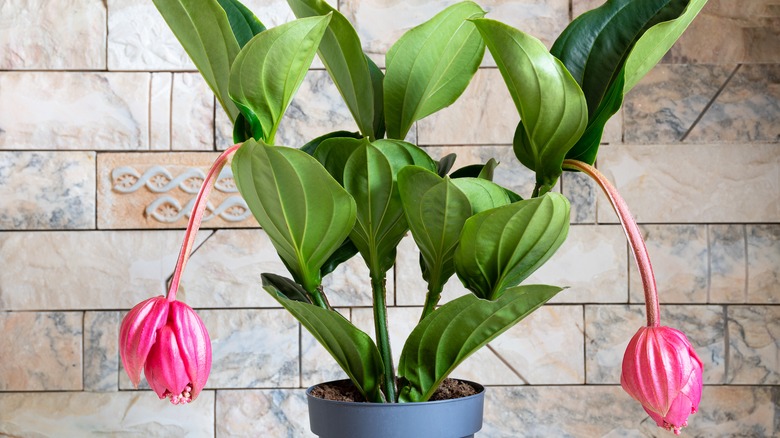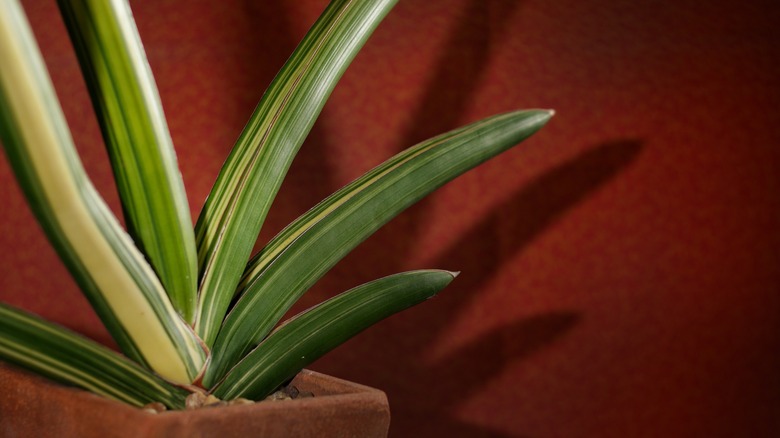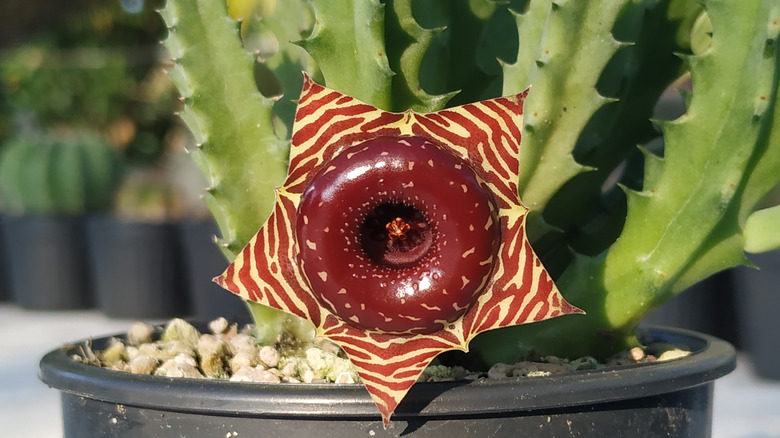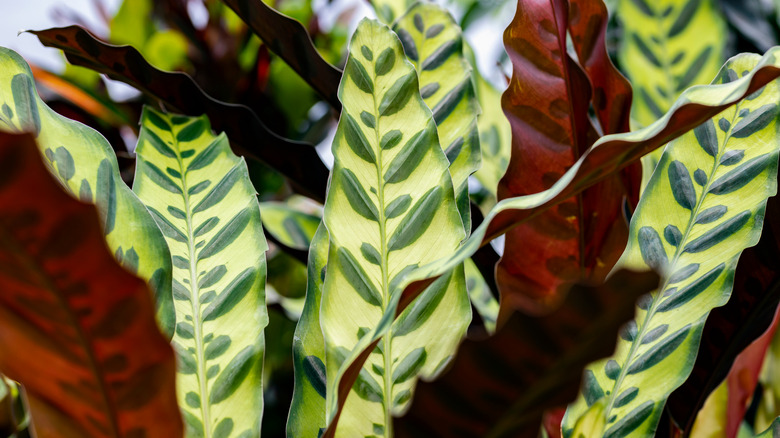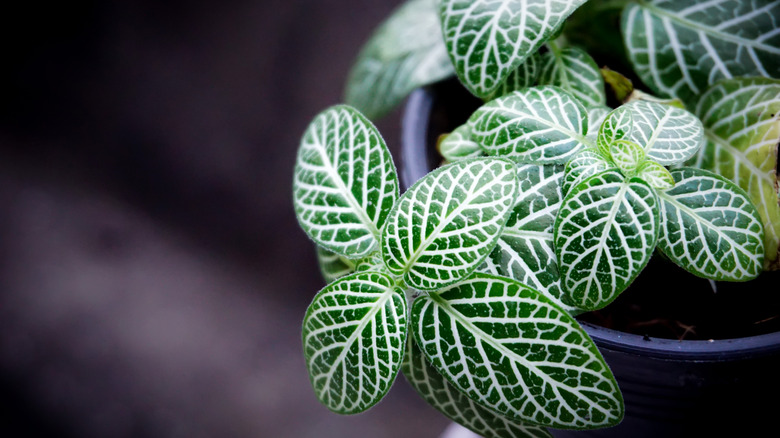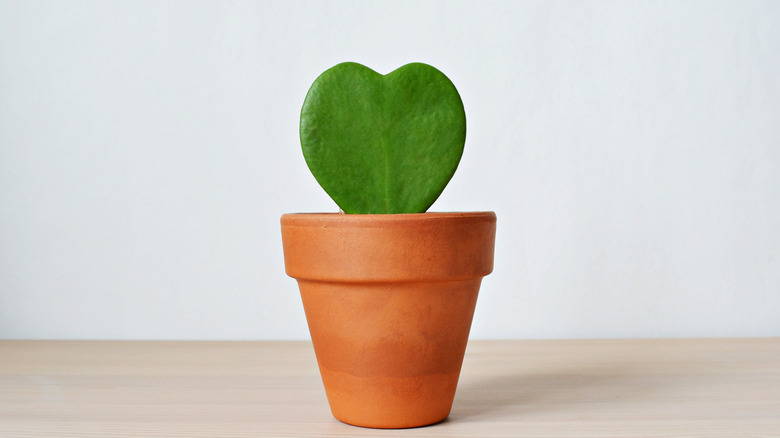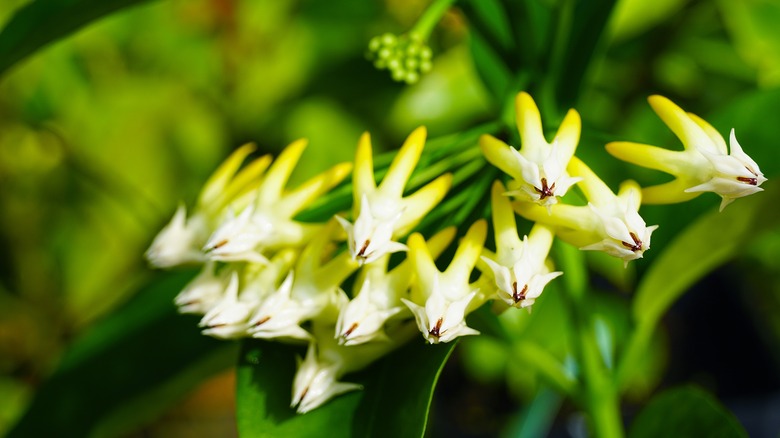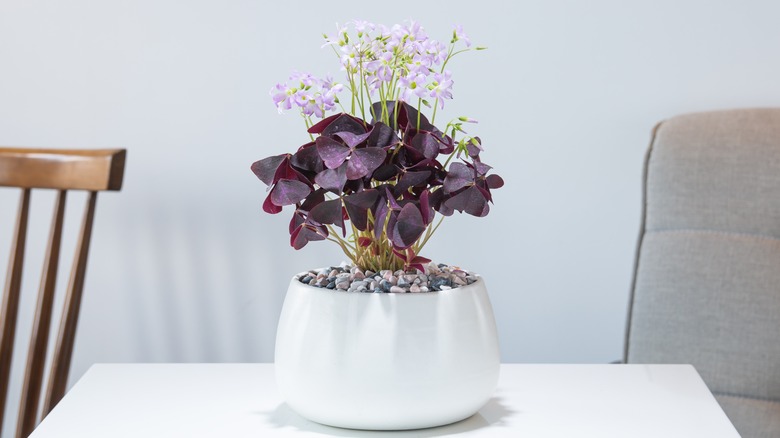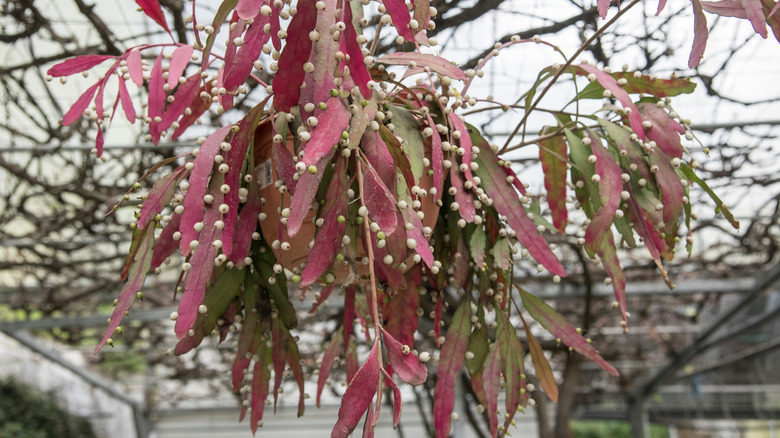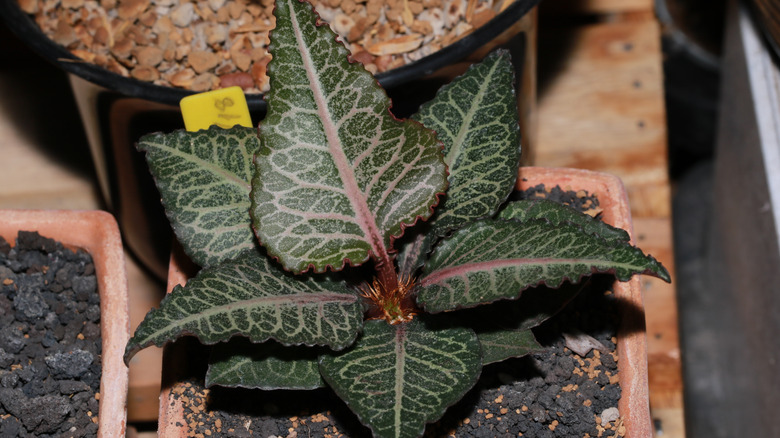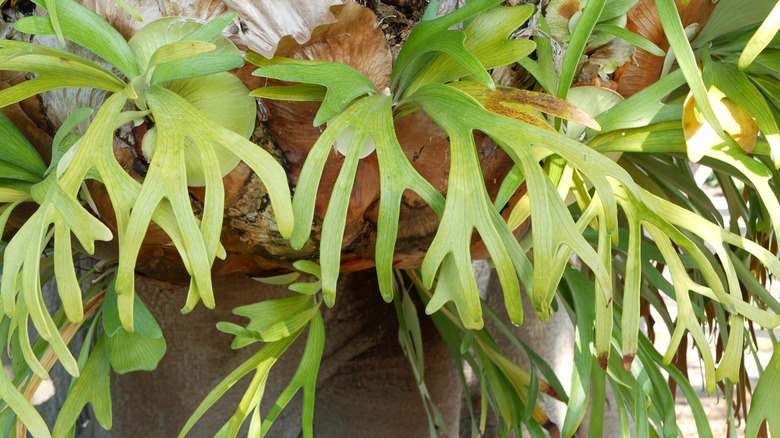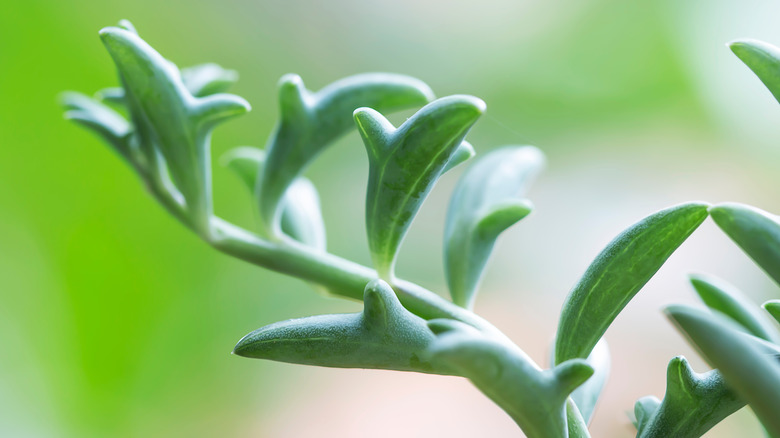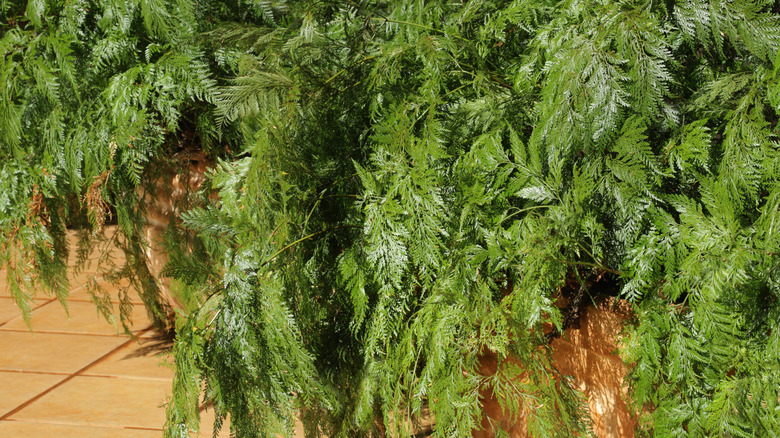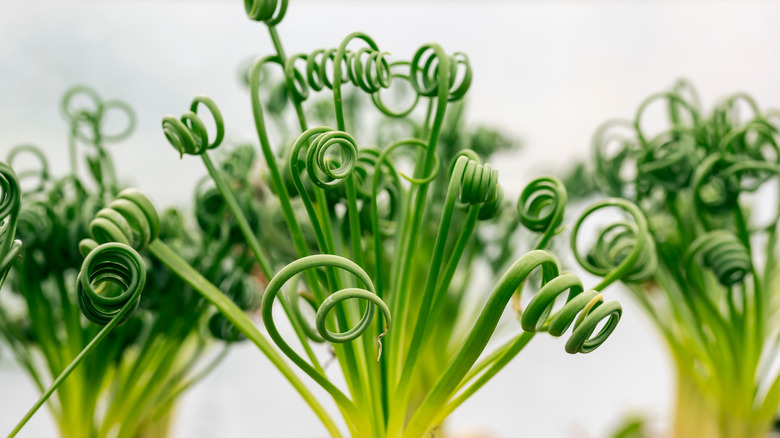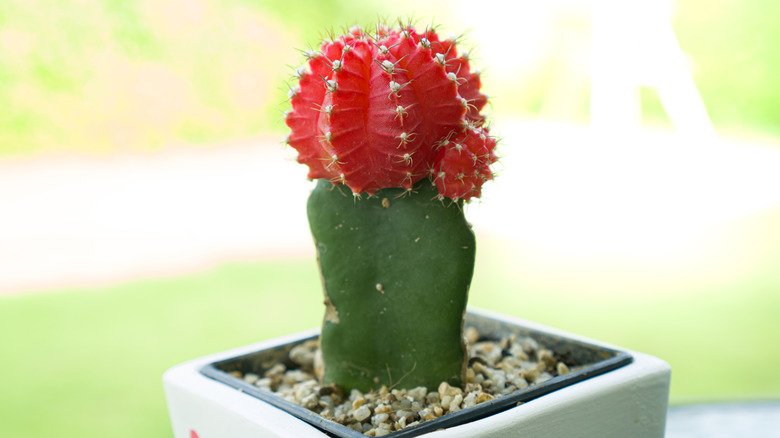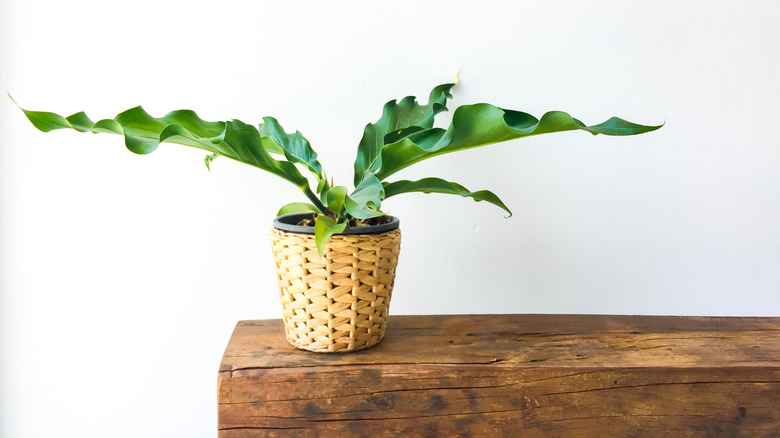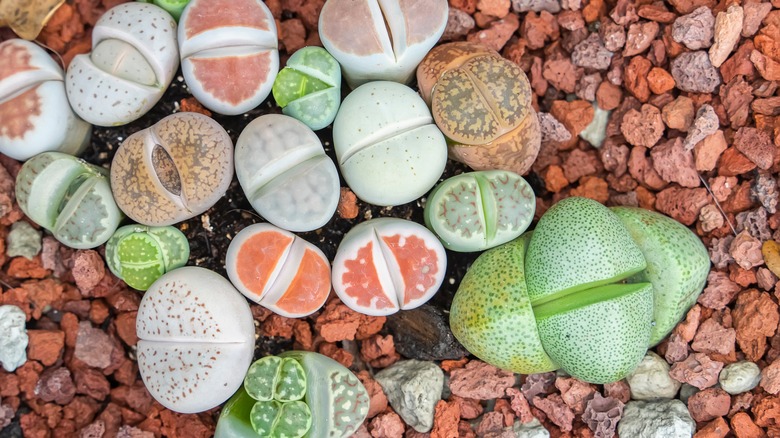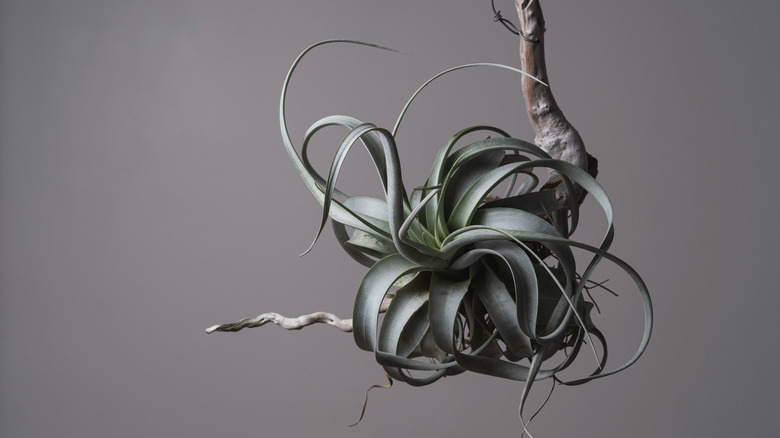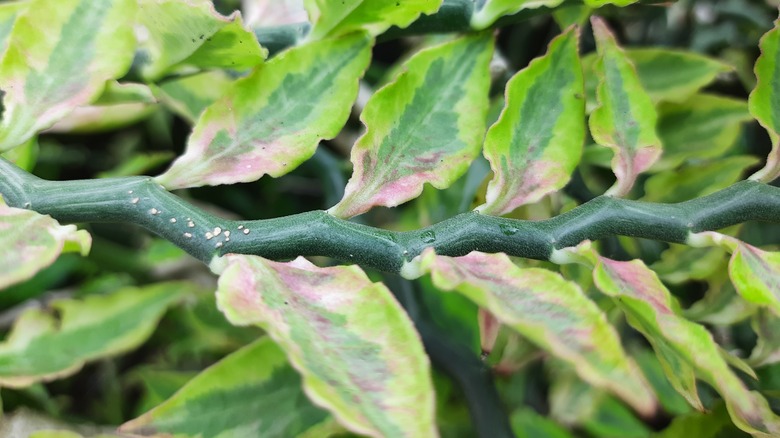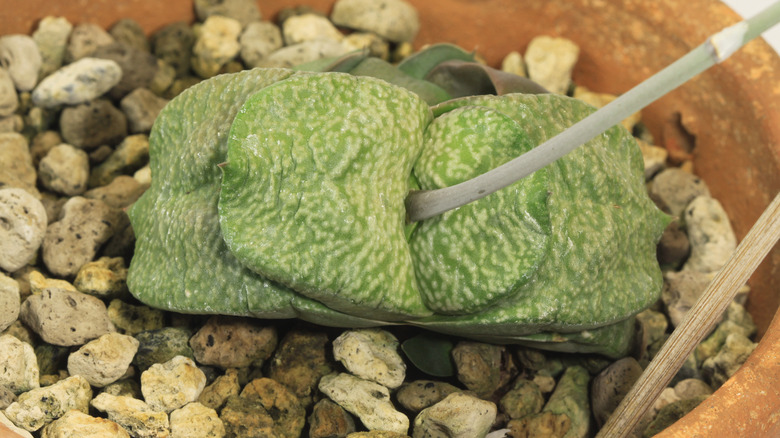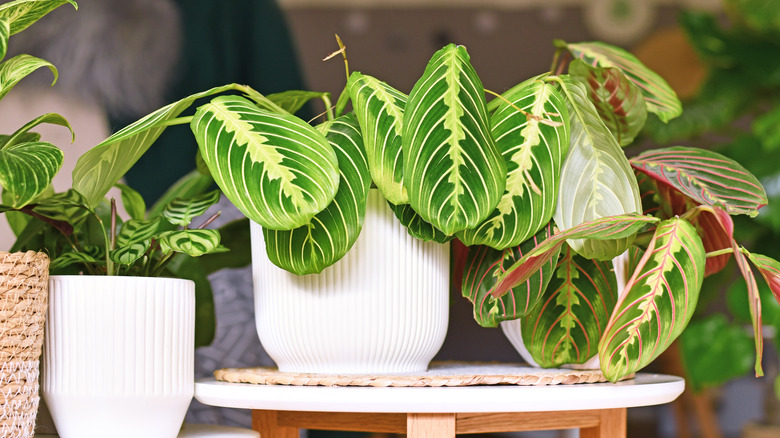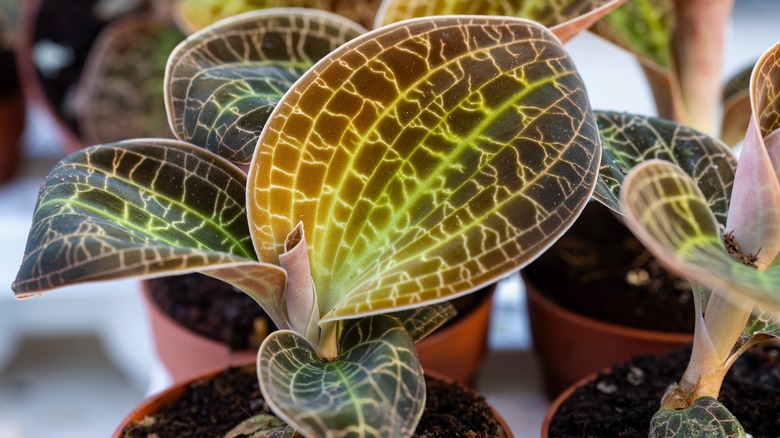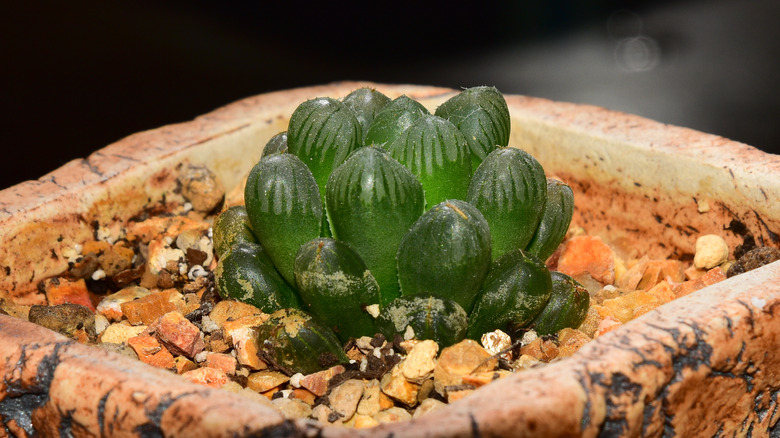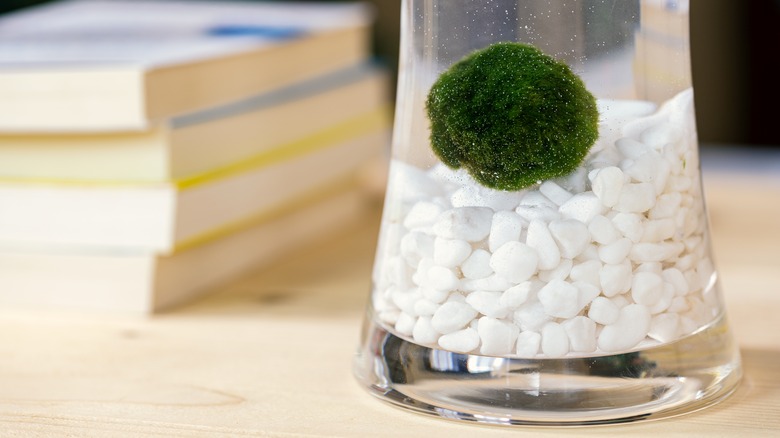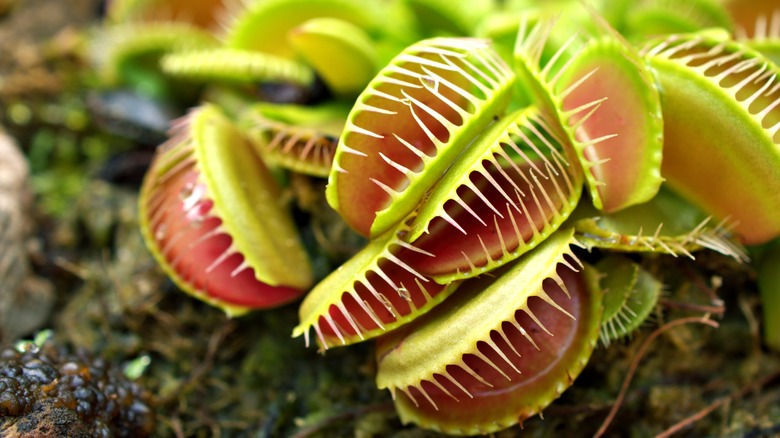25 Unique Looking Houseplants That Could Be Statement Pieces In Your Home
Despite what some may say, you don't need dozens of houseplants to make a green mark on your home. Sure, a shelf filled with some of our favorites like pothos, spider plants, pileas, and philodendrons will always look amazing, but it has been done again and again. If you like to take the road less traveled, try styling just one or two rare and exciting statement plants on your coffee table, dinner table, window sill, or anywhere else that needs a little more pizazz. Countless underused plants show off interesting shapes, colors, and growth habits — you just have to know where to look.
Many of these great show-stopping houseplants are actually very easy to grow, which we know is a concern for plant parents who have tried to grow beautiful but fussy houseplants before like the fiddle-leaf fig, as described by the University of California. With these statement plants, you don't have to worry about buying expensive soil, fertilizer, or habitats for them to grow in. For many of them, all you need is your trusty well-draining potting mix and the right size pot with drainage holes. Don't settle for another everyday houseplant. Your unique personality needs a plant that fits it. Just check out this collection to find one or more eccentric houseplants that are begging to be brought home.
1. Rose grape plant
Rose grape plants (Medinilla magnifica) are an epiphytic species that enjoy warm weather and a simple well-draining potting mix. Native to the Philippines, according to Logee's, the plants should be kept in a bright room with windows facing east or west. Despite being a somewhat obscure houseplant, the rose grape plant is very easy to grow as it is tolerant of dry air, drought, and regular pruning.
Sunlight Needs: Bright to medium indirect light
Water Needs: Allow soil to dry between waterings
Bloom Season: Spring and summer
Size: 2 to 3 feet tall
2. Baseball bat Sansevieria
Baseball bat Sansevieria (Sansevieria hallii) is a lesser-known snake plant species that produces blue-green, upright leaves and gorgeous white flowers on long stalks, as per San Marcos Growers. The houseplant is slow-growing and neglect tolerant, so you can leave it to grow for a long time without any worries.
Sunlight Needs: Bright direct or indirect light
Water Needs: Needs minimal watering
Bloom Season: Summer
Size: 3 to 4 feet tall and 4 to 5 feet wide
3. Lifesaver plant
The lifesaver plant (Huernia zebrina) is a unique succulent that receives its common name from its fleshy, red, and ring-like flower. The flower, as described by Logee's, commands attention while also needing little maintenance to survive. This warm-weather plant prefers a bright western or eastern-facing window.
Sunlight Needs: Bright indoor light
Water Needs: Allow soil to dry between waterings, water deeply each time
Bloom Season: Flowers intermittently indoors
Size: 3 to 8 inches tall
4. Rattlesnake plant
The rattlesnake plant (Calathea lancifolia), which is related to the peacock plant and the pin-stripe Calathea, is one type of prayer plant. Like the others, it has an interesting habit of folding up its leaves at night, as if in prayer, as said by Proven Winners. This houseplant often steals the show in indoor gardens as its leaves are naturally a striking bright green littered with darker green stripes and spots.
Sunlight Needs: Low to medium indirect sunlight
Water Needs: Needs consistent watering and moderate to high humidity levels
Size: 12 to 30 inches tall
5. Nerve plant
The nerve plant (Fittonia albivenis), also known as silver fittonia, is a low-maintenance Peruvian species. Though you can easily find this plant at your nearest nursery or box store, it still holds its own among other unique-looking growers. The herbaceous perennial shows off many green leaves that are veined with bright white, pink, or red depending on the variety, as noted by Missouri Botanical Garden.
Sunlight Needs: Bright, medium, or low indirect light
Water Needs: Needs regular but moderate watering and high humidity
Bloom Season: Summer
Size: 6 inches tall and 1 foot wide
6. Hoya heart plant
Hoya heart plants (Hoya kerrii) are one of the most adorable houseplants money can buy. They produce waxy heart-shaped leaves on long vines that may be green or green lined with yellow to cream variegation, as shown by Logee's. Keep in mind, this plant does grow quite slowly, so it can take a while for it to form new leaves.
Sunlight Needs: Bright direct or indirect light
Water Needs: Allow soil to dry out between waterings
Bloom Season: Summer
Size: 2 to 4 feet tall
7. Shooting star hoya
Another great Hoya plant is the shooting star hoya (Hoya multiflora). It is named for its bright white to yellow flowers that are star-shaped and born on long stalks. Logee's reveals that these flowers can bloom non-stop throughout the year in the correct conditions. Without the flowers, however, the shooting star hoya is still attractive, displaying thick green leaves and an upright growth habit.
Sunlight Needs: Bright to medium indirect light
Water Needs: Allow soil to dry out between waterings
Bloom Season: Spring and summer
Size: 12 to 18 inches tall
8. False shamrock plant
The false shamrock plant (Oxalis triangularis) is an easy-to-grow houseplant with an unusual color and triangular leaves. Like the prayer plant, the false shamrock closes its leaves at night and opens them again in the morning. Depending on where you live, these can make for a great patio plant when kept in a container, as suggested by North Carolina State Extension.
Sunlight Needs: Bright indirect light
Water Needs: Allow the surface of the soil to dry between waterings
Bloom Season: Fall and summer
Size: 6 to 18 inches tall and 12 to 24 inches wide
9. Red mistletoe cactus
The red mistletoe cactus (Pseudorhipsalis ramulosa) is unheard of by most until you go diving into the world of uncommon houseplants. This epiphytic cactus grows thin, pad-like leaves that can be green or dark red depending on how much sunlight it is exposed to, says Brian's Botanicals. Flowers and berries can appear on the edges of the leaves, but they are unlikely to form indoors.
Sunlight Needs: Bright indirect light
Water Needs: Allow soil to dry slightly between waterings
Size: 3 feet tall and 4 feet wide
10. Euphorbia francoisii
Euphorbia francoisii is loved for its truly unique foliage that rarely shows off the exact same shape and color. According to Gabbar Farms, the leaves can be pink, purple, green, white, or variegated. Like other Euphorbia species, this plant enjoys bright sunlight, minimal watering, and warm temperatures above 70 degrees Fahrenheit.
Sunlight Needs: Bright direct or indirect sunlight
Water Needs: Allow soil to dry several inches below the soil's surface between waterings
Size: 4 to 6 inches tall
11. Staghorn fern
Staghorn ferns (Platycerium bifurcatum) make wonderful houseplants. As told by the University of Wisconsin-Madison, younger and smaller plants can be grown in containers, however, the staghorn fern grows on trees in its natural environment. Because of this, some home gardeners mount theirs on wooden boards or bark slabs, which allow for perfect drainage and make the plants easier to manage.
Sunlight Needs: Bright indirect light
Water Needs: Water with rainwater regularly, they require more water when in direct sunlight
Size: 3 feet wide
12. String of dolphins
String of dolphins (Senecio peregrinus) is a cross between the string of pearls and the candle plant, as explained by Mountain Crest Gardens. This interesting houseplant can be difficult to find anywhere but online. It gets its name from its beautiful succulent leaves, which look like leaping dolphins. With good care, it can live for quite a long time and even show off its flowers, which are described as pom-pom-like.
Sunlight Needs: Bright indirect light
Water Needs: Drought tolerant, provide limited water
Bloom Season: Fall and winter
Size: More than 1 foot tall
13. Rabbit's foot fern
The rabbit's foot fern (Davallia fejeensis) looks like a normal leafy fern at first glance. However, its hairy-scaled surface rhizomes are what it's named for, as per Missouri Botanical Garden. These brown and hairy growths move their way down the sides of the fern's pot, which makes it look like it's standing on rabbit's feet.
Sunlight Needs: Bright indirect sunlight
Water Needs: Water regularly during the growing season
Size: 1 to 3 feet tall and 1 to 4 feet wide
14. Fizzle sizzle plant
The fizzle sizzle (Albuca spiralis) is a whimsical plant that looks as if it came out of a children's book. It features long green stems that can reach up to a foot high and swirl at their ends. As explained by Logee's, the plant grows from a bulb, which also produces lightly vanilla-scented yellow flowers in the spring from tall stalks.
Sunlight Needs: Bright indirect light
Water Needs: Water regularly during the growing season, but allow the soil to dry out slightly between waterings
Bloom Season: Spring and summer
Size: 1 foot tall
15. Moon cactus
The moon cactus (Gymnocalycium mihanovichii) is actually made up of two separate species, which are grafted together. One cactus sits atop the other, which provides it with essential chlorophyll that it cannot produce on its own due to its bright color, as taught by Planet Desert. Though many types of cacti can be grafted on top of one another, this one is especially loved for its peculiar look.
Sunlight Needs: Medium indirect light
Water Needs: Requires little watering during the growing season, do not water in the winter
Bloom Season: Spring
Size: Up to 1 foot tall
16. Bird's nest Anthurium
Bird's nest Anthurium (Anthurium plowmanii) is a large and leafy tropical species that can be grown indoors in a large container. You would not want to stuff this plant into a small apartment unless you want to feel like you're living in a jungle. It grows very quickly, even under conditions that are not necessarily ideal, as said by Ken's Philodendrons.
Sunlight Needs: Bright indirect light
Water Needs: Water regularly during the growing season
Size: Up to 6 feet tall, much smaller indoors
17. Living stones
Living stones (Lithops spp.) might trick you into thinking that they are not living at all. These rock-like succulents are typically just 1 to 2 inches across and they show off a gray, purple, silvery green, or muted red color, as shown by Mountain Crest Gardens. With good care, these inconspicuous plants will bloom with comparably large flowers that are yellow and white.
Sunlight Needs: Bright direct light
Water Needs: Water sparingly in the fall and spring
Bloom Season: Fall
Size: Less than 3 inches tall
18. Air plant
Air plants (Tillandsia spp.) are one of the few plants that can grow literally anywhere in your home with little maintenance. You can place these little guys in the nooks of your kitchen, on shelves all over your home, or hanging from the ceiling. They require no soil, as per Penn State Extension, and you can simply mist them often or give them a soak once every week or so.
Sunlight Needs: Bright indirect sunlight
Water Needs: May be rinsed or soaked once a week, may need supplemental misting in dry environments
Size: 2 to 12 inches tall
19. Devil's backbone
The devil's backbone plant (Pedilanthus tithymaloides), also known as the redbird flower, is a broadleaf evergreen plant that produces zigzagging stems and small green leaves that are usually just 3 inches long, as described by Missouri Botanical Garden. Keep in mind this unique houseplant does have poisonous properties, so you'll want to make sure it is far out of reach from children and pets.
Sunlight Needs: Bright to medium indirect light
Water Needs: Consistent but moderate watering throughout the growing season, less in the winter
Size: 2 to 6 feet tall and 1 to 3 feet wide
20. Flat-leaf Gasteria
Flat-leaf Gasteria (Gasteria armstrongii), which is also sometimes called ox tongue, is an aloe-like succulent species that shows off short, thick green leaves that taper at their ends. Because the leaves grow opposite of one another, some of these plants look like multiple tongues coming out of the soil. San Marcos Growers notes that the plant also produces pink flowers in the spring, however, the Gasteria plant rarely blooms indoors.
Sunlight Needs: Bright indirect light
Water Needs: Water sparingly in the fall and spring
Size: 2 inches tall and wide
21. Prayer plant
The prayer plant (Maranta leuconeura) makes for a great houseplant and a fun conversation starter. The plant is named for its large multi-toned leaves that splay outward during the day and fold upward into each other at night, as Missouri Botanical Garden explains. You'll want to be sure that this tropical plant is kept out of direct sunlight, which is known to bleach its leaves, taking away the attractive color it is grown for.
Sunlight Needs: Bright indirect light
Water Needs: Soil must be kept consistently moist
Size: 6 to 12 inches tall and wide
22. Jewel orchid
The jewel orchid (Macodes petola) is known for its foliage that looks as though it is lit up with lights along its veins. The plant should be kept in a low-light environment where it is rarely exposed to bright indirect light. Still, to see its glowing leaves, some light or an LED flashlight has to be shined on them, says Orchid Web. Try to do this minimally to keep the plant in good health.
Sunlight Needs: Low indirect light
Water Needs: Soil must be kept lightly moist between waterings
Bloom Season: Varies
Size: About 1 foot tall
23. Cooper's Haworthia
Cooper's Haworthia (Haworthia cooperi var. truncata) has bubble-like leaves that draw people to it. Most often, the thick succulent leaves are a translucent light green color, but they can become reddish if they are made to tolerate bright indirect light or drought, as expressed by Mountain Crest Gardens. If you are new to growing plants inside your home, this one is a beginner-friendly plant that can be difficult to kill.
Sunlight Needs: Low indirect light
Water Needs: Allow soil to dry completely before deeply watering
Size: 3 to 5 inches tall and wide
24. Marimo moss ball
Marimo moss balls (Aegagropila linnaei) are likely a plant that you've seen but haven't considered growing. These moss balls are unbelievable plants, they require very little maintenance, and they appear man-made. The Marimo moss balls can also be useful if you have freshwater fish because they can improve water quality by creating oxygen and removing nitrates in fish tasks, according to Fish Laboratory Aquatics.
Sunlight Needs: Medium to low indirect light
Water Needs: Lives in tap water
Size: 3 to 4 inches in diameter, sometimes larger up to 12 inches
25. Venus fly trap
Venus fly traps (Dionaea muscipula) are frequently passed over as houseplants, though they are one of the most well-known carnivorous plants, as told by Missouri Botanical Garden. Native to the southeastern part of the United States, these feisty little plants have so much personality. You can grow your own green friend from your kitchen, office, bedroom, or living room.
Sunlight Needs: Bright indirect sunlight
Water Needs: Soil must be consistently moist and bog-like
Bloom Season: Spring
Size: 6 to 12 inches tall and 6 to 9 inches wide

